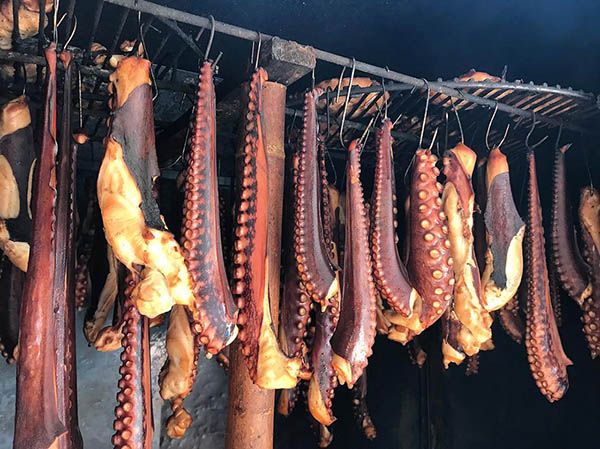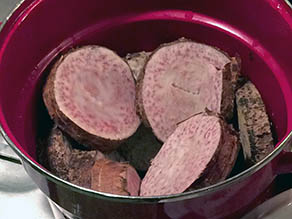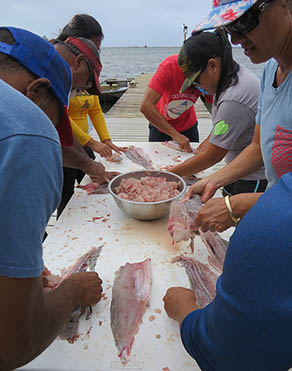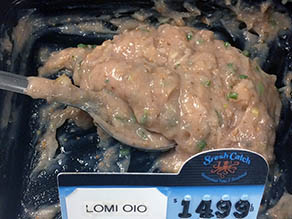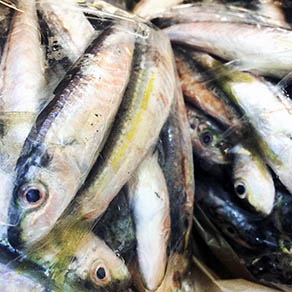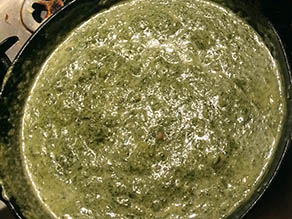 |
 |
 |
 |
||||||
|
|
|
|
|
|
|
|
|
|
 |
|
 |
|||||||
 |
“A lot of our Church members, the old members used to be kalo (taro) farmers on their own,” Emalia recalls. “They used to raise kalo—I mean, that was the only thing that grew. There were huge taro farms across from where the Mormon Church sits, across the street was all taro. Eventually it was replaced by rice. So we grew everything we ate, and we ate everything from the bay when it wasn’t polluted. “We ate a lot of taro,” Alice says, “because we cleaned the taro before we’d go to school and we’re going to come home and then do whatever was left with the taro, clean up the poi mill and we have to do all that after school. We had the poi mill right across from where King’s School is now. We had to work in the poi factory, we had to clean it up when everything was done and ready for the next day. Taro, we fried it in the morning, put butter or jam on it. "Oh, we ate good. We ate good. We really ate good because we raised chickens. I hate chicken. Today I hate chicken because we raised about a thousand chickens. I am not a chicken lover. I'll eat chicken but not really love of the chicken. Everybody had. "We traded eggs for milk with the dairy farm right across our house. It was a dairy there where the Mormon Church is now. It used to be all pasture there, where He‘eia Crown Terrace is, where the Catholic school is, except for then there was all land, all pasture land. Couple of chicken areas. Read about sweet versus sour poi “We ate plenty of fish before, growing up. We had an uncle that went into the water for hours. We don’t know where he was but there’s a cave out there. I don’t know the name of the cave, where He‘eia state park, it goes toward Kapapa, there’s two little islands on this one. There’s a cave, we never went there in the water, but my uncle, he’d be there for hours and hours. He comes back... I don’t think he did all the fishing, but he got those fishes. ‘Ō‘io, mullet, he get big octopus. The octopus were big, really big. All the different kind of fishes. We only eat the ones that get the meat. There was manini, it wasn’t a favorite fish, my family used to love that, they just charcoal. “‘Ō‘io is still my favorite because we have to go catch all... now we don’t go catch them... when they dream that ‘ō‘io, they come back for fishing. And there’s ‘awa, the other and there’s a lot of bones, so that’s why pack and get it. We have to clean them, scrape them. Just the meat, no more bones because there’s a lot of bones in that fish. They scrape the meat off the bone and then pack it, whoever wants it take that home. Pack it in containers, whoever wants to take the fish home and when we’re done, we put in the freezer. You got to freeze the fish. My cousin is a good maker of that. You got to have the hand. “Lomi ‘ō‘io, that’s my favorite,” Hi‘ilei says. “Lomi ‘ō‘io, lomi awaawa. That’s one of my favorite raw preparation methods.” “You eat it raw, with salt, chili pepper—oodles of it—and some onion with the poi,” Alice explains. “Of course we never starved for poi because we had the poi factory. We never starved for poi. There was poi every day. Not fish every day, but poi every day. “My dad was a good cook and we also raised rabbit, so we had a lot of rabbits because they make a lot of babies. So my dad would kill them and freeze them so he can make fricassee out of it. “No turtles. That was sacred for the family. No turtle. Even we respect the sharks. That’s why I tell myself, how did my uncle go in that deep water and not meet up with a shark or something? Because that’s deep water. But they’re always friends—he said he talked to the fishes but he’s not here to tell me that now. He’s gone a long time but he was like a jolly king giant, he was big. It took us long time to see him go out of sight because he was so big. “We never talked stink around the poi bowl. Nobody does. We were good kids, gotta be, because we had one uncle. If one guy did wrong, everybody gets a lickin’ and we don't want that so we’re all respectful and everything. You just take one guy and there are 10 or 15 of us, we all get lickings, no way. And then you get double licking when they catch you on the outside. So you gotta... everybody kind of respect and we grew up to respect the elders anyway. We were taught that way to respect. Even if you didn’t like what they said, you respect the elders. My mom’s mad.” Nick Reppun talks about the poi bowl traditions. “My grandma, between her, her husband and his first family and his family with my grandma’s like 18 or 19 children there. So everybody kind of lives together. No matter if your mom passed away. Our grandma and grandpa, they raised the other family so that’s how it was: all took care of each other. Now it’s not like that. We still kind of do... I lost my sister, and we raised her three boys with my nine children and her three boys, but we have to make do. So when you cook, you got to cook big. Even when they’re young we cook big. “My cousin’s wife made breakfast for us in the morning. A lot of times we had hot cakes. Most of the time was taro. Taro with butter and jelly and whatever you want. Just like taro slice. As you have taro all cut in bit pieces with sugar and cream. Oh, that was good. And we go to school and that was our breakfast, yeah. We took sandwiches to school because at that time there's no cafeteria. But at ‘oama times, they wanted the fishes, they go catch. There’s a season for ‘oama. Then you get ‘oama and rice for lunch. Fried, so you chew the bone and all.” The waters of Kāne‘ohe Bay are famous for octopus, or he‘e. “Traditionally, you eat it raw,” Hi‘ilei explains. “We make a dish called raw he‘e: you cut it up super thin and you mix it with the liver of the octopus and you add Hawaiian chili pepper, other things, inamona and salt. You eat it raw like that. There’s other ways to eat it, like we’ll put it in squid lū‘au. Or what we call lū‘au he‘e, which is cooked-down taro leaf, coconut milk, and octopus with a little bit of sugar or a little bit of something to sweeten it. That is a labor of love. That dish is a pain in the butt. If you know what goes into it, then you have really great appreciation for it. “We’ll also dry he‘e. We salt it, rinse it, dry it for two to three days depending on the weather. We finish it in the broiler oven, and it comes out like...I don’t know how to describe it, not like cuttlefish. We call it dried he‘e. We also smoke it similarly, except it has a smoky taste, called smoked he‘e. We also make poke, like tako poke: just boil it, cut it thin, and then mix it with all kinds of whatever: seaweed, shoyu, green onion, onion, sesame oil. “Nowadays, we like to prepare like how you would eat calamari rings. So we’ll boil it, cut it up, garlic, salt, black pepper, corn starch, and then deep fry it and make little poppers. So good! That’s about it. We’re definitely not lacking in he‘e in any of our freezers. Everybody comes to us if they need octopus. That’s a practice that was taught to me by my dad. My dad learned it from his dad, and so on and so forth.” |
 |
|
 |
Of course, food production is enabled by, and accomopanied by, the presence of water.
|
 |
||
 |
|
 |
||

|
 |
||||
|
||||
Copyright 2019 Pacific Worlds & Associates • Usage Policy • Webmaster |
||||
